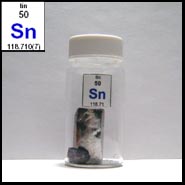| Property | Value |
|---|---|
| Atomic number | 50 |
| Atomic weight | 118.7107 amu |
| Element family | Other metals |
| Electronic configuration | 1s2 |
| Stable and very long lived isotopes | 112Sn: 0.97%, 114Sn: 0.65%, 115Sn: 0.34%, 116Sn: 14.54%, 117Sn: 7.68%, 118Sn: 24.22%, 119Sn: 8.58%, 120Sn: 32.59%, 122Sn: 4.63%, 124Sn: 5.79% |
| Previous element | Indium |
| Next element | Antimony |
| Density | 7.287 g/cm3 (STP) |
| Melting | 232.06 °C |
| Boiling | 2270 °C |
| Covalent radius | 1.4 Å |
| Van der Waals radius | 2.17 Å |
| Ionic radius | 0.69 Å |
| First ionization potential | 7.344 eV |
| Electron affinity | 1.112 eV |
| Electronegativity | 1.96 |
| Discovery year | 3500 BC |
Tin is an element number 50 from other metals family. Its symbol is Sn. Tin atomic weight is 118.7107 amu. Sn stable and long lived isotopes are 112Sn: 0.97%, 114Sn: 0.65%, 115Sn: 0.34%, 116Sn: 14.54%, 117Sn: 7.68%, 118Sn: 24.22%, 119Sn: 8.58%, 120Sn: 32.59%, 122Sn: 4.63%, 124Sn: 5.79%. Tin electronic configuration is 1s22s22p63s23p63d104s24p64d105s25p2. Sample compounds that contain Tin are SnO2, SnF2, SnCl2, SnCl4, SnO, SnI4.

Please let us know how we can improve this web app.

